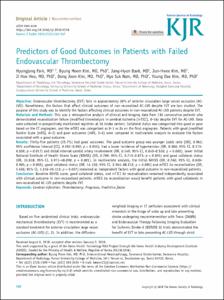Predictors of Good Outcomes in Patients with Failed Endovascular Thrombectomy
- Keimyung Author(s)
- Park, Hyung Jong
- Department
- Dept. of Neurology (신경과학)
- Journal Title
- Korean Journal of Radiology
- Issued Date
- 2020
- Volume
- 21
- Issue
- 5
- Abstract
- Objective:
Endovascular thrombectomy (EVT) fails in approximately 20% of anterior circulation large vessel occlusion (AC-LVO). Nonetheless, the factors that affect clinical outcomes of non-recanalized AC-LVO despite EVT are less studied. The purpose of this study was to identify the factors affecting clinical outcomes in non-recanalized AC-LVO patients despite EVT.
Materials and Methods:
This was a retrospective analysis of clinical and imaging data from 136 consecutive patients who demonstrated recanalization failure (modified thrombolysis in cerebral ischemia [mTICI], 0–2a) despite EVT for AC-LVO. Data were collected in prospectively maintained registries at 16 stroke centers. Collateral status was categorized into good or poor based on the CT angiogram, and the mTICI was categorized as 0–1 or 2a on the final angiogram. Patients with good (modified Rankin Scale [mRS], 0–2) and poor outcomes (mRS, 3–6) were compared in multivariate analysis to evaluate the factors associated with a good outcome.
Results:
Thirty-five patients (25.7%) had good outcomes. The good outcome group was younger (odds ratio [OR], 0.962; 95% confidence interval [CI], 0.932–0.992; p = 0.015), had a lower incidence of hypertension (OR, 0.380; 95% CI, 0.173–0.839; p = 0.017) and distal internal carotid artery involvement (OR, 0.149; 95% CI, 0.043–0.520; p = 0.003), lower initial National Institute of Health Stroke Scale (NIHSS) (OR, 0.789; 95% CI, 0.713–0.873; p < 0.001) and good collateral status (OR, 13.818; 95% CI, 3.971–48.090; p < 0.001). In multivariate analysis, the initial NIHSS (OR, 0.760; 95% CI, 0.638–0.905; p = 0.002), good collateral status (OR, 14.130; 95% CI, 2.264–88.212; p = 0.005) and mTICI 2a recanalization (OR, 5.636; 95% CI, 1.216–26.119; p = 0.027) remained as independent factors with good outcome in non-recanalized patients.
Conclusion:
Baseline NIHSS score, good collateral status, and mTICI 2a recanalization remained independently associated with clinical outcome in non-recanalized patients. mTICI 2a recanalization would benefit patients with good collaterals in non-recanalized AC-LVO patients despite EVT.
- Keimyung Author(s)(Kor)
- 박형종
- Publisher
- School of Medicine (의과대학)
- Citation
- Hyungjong Park et al. (2020). Predictors of Good Outcomes in Patients with Failed Endovascular Thrombectomy. Korean Journal of Radiology, 21(5), 582–587. doi: 10.3348/kjr.2019.0578
- Type
- Article
- ISSN
- 2005-8330
- Source
- https://www.kjronline.org/search.php?where=aview&id=10.3348/kjr.2019.0578&code=0068KJR&vmode=FULL
- Appears in Collections:
- 1. School of Medicine (의과대학) > Dept. of Neurology (신경과학)
- 파일 목록
-
-
Download
 oak-2020-0094.pdf
기타 데이터 / 112.06 kB / Adobe PDF
oak-2020-0094.pdf
기타 데이터 / 112.06 kB / Adobe PDF
-
Items in Repository are protected by copyright, with all rights reserved, unless otherwise indicated.